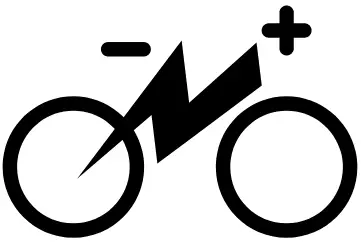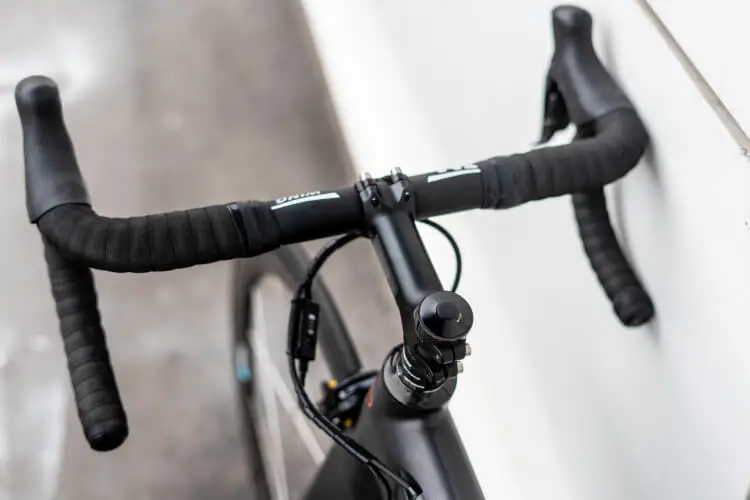A lot of articles talk about the importance of making sure your bike is the right fit. While a lot of attention is focused on things like saddle position and handlebar height, an overlooked aspect is handlebar width. While the other parts are important, having the right handlebar width is something that can make a big difference in control and comfort.
So, if you’re wondering how to choose a handlebar width and make a noticeable improvement to how you ride, carry on reading below. We look at how different widths impact different riders and the best way to choose the right width for you.
So how wide should handlebars be? The ideal handlebar width for road bikes is 38-46 cm. For mountain bikes, the width is 740mm or 760mm. Narrow handlebars will give you more speed and agility, while wider handlebars will give you more control and stability.
How Wide Should Handlebars Be?

Both road bikes and mountain bikes come with a wide range of width options for handlebars. Like many things in cycling, sizes vary a lot. While a new bike will often come with something average, it won’t necessarily fit your body type or riding style.
Unlike the seat height which can be adjusted quickly with an Allen wrench, changing your handlebar requires more work. This is why it’s best to pick out a good handlebar from the beginning if you can. But what is the ideal width for handlebars?
Road Bike HandleBar Width
Handlebars for road bikes often fall between 38-46 cm. There are lots of different factors to take into consideration, but your body size, and particularly the size from shoulder to shoulder is key.
When you’re getting measured for a bike, the fitter should measure you across the shoulder joints to find a suitable bar for you. How wide is between your shoulder joints will be an indicator of how wide your handlebars should be. This will put your arms in a relaxed position.
While your body size matters, riding style also matters. Different styles of riding have a big impact. Some riders prefer to stay in the saddle and some prefer their elbows out.
Along with riding style, your riding position is yet another factor. When all the measuring is complete, you still need to feel comfortable and have good control of your bike. While being measured is a necessary step, personal preference is just as important.
It’s also worthwhile to know that handlebar width has been influenced by trends. For example, there may be a trend towards wider bars for a few years only to be replaced with an opposite trend in the future. The specification of parts on the road bikes we see in stores is often influenced by what the professional riders are using. While trends change frequently, there is currently a general move towards the smaller widths with 38cm and 40cm being particularly favored by professional riders.
MTB Handlebar Width
Initially, mountain bikes had quite narrow bars as they took their influence from road bikes. However, as stability is key in mountain biking, the sizes started gradually increasing as the bikes evolved. By the time mountain biking was fully established, the widths available had become unrecognizable from road bikes.
Currently, MTB handlebars are usually 740mm or 760mm. This is significantly wider than the equivalent on a road bike. There is also a bigger range of size options available for mountain bikes due to the variety of different disciplines. It’s not uncommon for downhill mountain bikes to have particularly wide bars. Some downhill mountain bikes have a width of 820mm, a big difference from 600mm that was seen in the past.
Benefits of Narrow Handlebars
With a range of sizes available and body size not being the only factor, why do riders choose narrow or wide handlebars?
For road cyclists, narrower bars are more aerodynamic. Not only are the bars fractionally smaller but you’re encouraged to move your elbows inwards promoting a more streamlined position. Professional riders will also claim the narrow width helps them maneuver through the peloton without clipping other riders’ bars. For the rest of us, it might be more likely that we are able to maneuver through traffic better and avoid parked car mirrors. But, the narrowness can definitely help.
So why isn’t everyone choosing narrow bars if they help with speed? Well, with the speed comes a price: a reduction in control. The more narrow the bars are, the less stable the bikes becomes. So, if you’re looking for the most stable ride, you’re likely to be suited to a wider bar. Some riders also like the wider bars to pull on and gain traction from when riding fast.
Benefits of Wide Handlebars
Riders who move around a lot in the saddle can benefit from pulling against the width of larger bars. So knowing your riding style can be an important piece when getting the right handlebar.
If you’re just starting out with road biking, you may benefit from the stability a wider bar offers. Once you gain some experience, you can always try a shorter handlebar. This will help increase your speed and put you in a more aerodynamic position. There’s a chance too that you can better avoid catching trees or rocks.
For downhill riders, it is very much the opposite. Stability is key for downhill mountain biking. The extra control wide bars allow riders to push the speed faster and faster. This easily outweighs any aerodynamic benefit that narrower bars would provide.
Narrow vs Wide Handlebars
In general, narrow bars will make a bike more agile. If you need to travel through traffic and turn tightly, narrow bars provide an advantage. However, wide bars offer both stability and extra leverage. Some riders feel that using wider bars forces them to spread their shoulders, and subsequently open up their chest. This is believed to allow more oxygen to be taken on board which improves aerobic performance. Like most things in cycling, there are varying opinions on just how effective this is.
The terrain that people ride on also plays a part. The more uneven the terrain the more stability is required. Often hybrids and gravel bikes will specify handlebars from the wider end of the road bike range. Typically, these bikes will encounter more than the flat smooth pavement that a road bike is designed for, so the increase in width makes sense.
As mountain bike terrains vary a lot, there needs to be a variety of widths to accommodate riders. For a single track running tightly through trees, you can see why wide bars wouldn’t be a preferred choice. But they would be ideal for rough terrain or extreme downhills.
Can You Change the Handlebar Width On the Same Bike?
Handlebars, particularly if they are made of alloy, can be cut down to reduce their width. It’s something you can do at home yourself with a hack saw. If you have bars that are too wide for comfort or don’t suit your riding style, then you have a no-cost option to make them fit. Not everyone is comfortable with this method though, so replacing them might be a better option.
If the bars are too short, then your options are more limited You can, however, swap bars on a bike easily and without too much trouble.
While it isn’t a particularly labor-intensive job, it is probably not something that you would want to do every day. Especially so if you ride a road bike, as you need to remove and reapply the tape.
So, if you were considering different handlebars for different terrains it is possible, but you may find it starts getting frustrating if you need to do it often. It’s also likely that your bike might be suited to a certain terrain or type of riding that isn’t in line with any other bars you attach. As people get more experienced, they often end up with different bikes rather than different handlebars.
Final Word
We would always recommend you start by being measured for any significant bike part, and handlebars are no different. A 5’3″ rider will need a smaller width than a 6’3″ rider. But as we said, body type isn’t the only important factor. You should also consider the terrain and the type of riding you’re likely to be doing.
For many riders, an average sizing will be just fine for road or mountain bike options. But for people looking for speed or want extra stability, a handlebar a little shorter or longer would be better.

